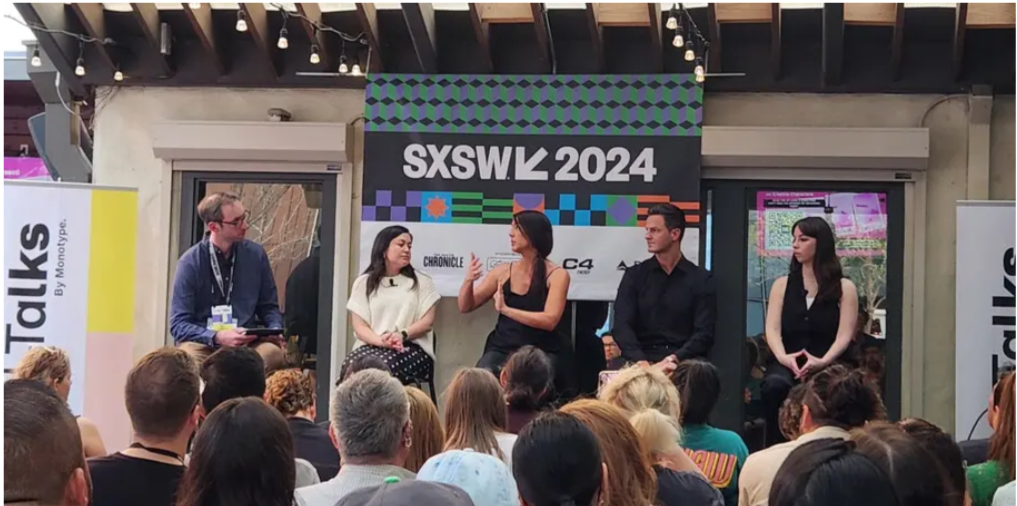
How do brands inspire butterflies? How can a font give goosebumps? Why do specific memories spring to mind at the sight of a certain composition of colors and lines? In short, why do we love typography in branding?
During this year’s SXSW 2024 in Austin, Texas, Monotype, a global leader in type and technology, brought its Creative Characters podcast to Austin, for its first-ever live recording on stage, in addition to an unofficial, off-site installation at Cedar Door. The event brought several guests together for a special taping of the “Creative Characters” podcast.
The company partners with leading foundries to deliver the broadest inventory of high-quality typefaces in the world. With a library of over 150,000 fonts and the product of the world’s most celebrated and gifted type designers, Monotype’s expansive library includes some of the most famous and widely-used fonts, such as the Helvetica®, Univers® and Frutiger® typeface families, as well new an innovative fonts like Posterama and Masqualero.
Moderated by Monotype’s Senior Director of Partnerships, Bill Connolly, the panel showcased a diverse lineup of brand builders – Valerie Vacante, VP of Solutions Innovation at dentsu, Jessica Staley, Director of Brand Design at eBay, Holly Fraser, VP of Content at WeTransfer & WePresent, and Mike Storm, COO of Neurons – for a thoughtfully curated episode that explored questions like –
How do brands inspire butterflies?
How can a font give goosebumps?
Why do specific memories spring to mind at the sight of a certain composition of colors and lines?
These questions helped fuel conversations centered on providing valuable insights for marketers seeking to build long-term equity in brands, rather than quick profits.
“How do you stay timeless and futuristic when making type decisions?” – Jessica Staley, Director of Brand Design at eBay
Jessica Staley of eBay kicked off the 60-minute discussion by emphasizing the importance of trusting your gut instincts during major rebrands.
She told a story of working on a rebrand for American online real estate platform, Trulia, where they wanted to capture the essence of community in the identity. Working with Monotype Executive Creative Director Phil Garnham, they were able to infuse the typeface with attributes that represent the characteristics of different neighbors and neighborhoods. Jessica also spoke of the importance of “knowing when to trust your gut as much as the strategy itself” and the importance of “pushing out over your skis” to anticipate and solve problems of the future before your customers even realize they have a problem.
She reflected on lessons from the 2017 rebranding of the American online real estate platform, Trulia, where they wanted to capture the essence of community in Trulia’s identity. Together, with Monotype’s Executive Creative Director Phil Garnham, they were able to infuse Monotype’s typeface with attributes that best represented the characteristics of different neighbors and neighborhoods.
Staley further emphasized balancing trends with honoring a brand’s emotional qualities when rebranding legacy brands, using eBay as an example of how they used emotional storytelling and visual identity updates in their COVID-19 pandemic rebrand.
“Hearing that something is ‘simple’ is the biggest compliment” – Valerie Vacante, VP of Solutions Innovation at dentsu
Val Vacante of Dentsu Innovation shared how observing real consumer behaviors directly informed new product development.
She told the audience about a scannable tool her team built for Glenfiddich Whiskey that leverages AI to pull information directly from their brand content about the whiskies. By pulling from their already-approved brand content, there’s no risk of the AI sharing inaccurate information.
She then explained that this product could even help address consumers’ demand for product information in stores – think ingredients for people with allergies. Noticing shoppers’ desire for ingredient details led to a contactless payment solution providing that information on scan – directly solving a need. Such insights highlight the power of understanding audiences holistically.
She highlighted her experience building “simple, frictionless experiences” and the importance of prioritizing those experiences. While it’s easy to get wrapped up in trying to solve all the problems when building new tech or experiences, Vacante advised Brand Impact attendees that it’s better to start by creating very simple test-to-learn prototypes that solve the main problem.
After all, “the experience is the brand,” as she put it.
“You don’t design because you want to make things that look great, it’s because you went to tell a story” – Mike Storm, COO at Neurons
Neuroscientist Mike Storm emphasized gaining a deeper understanding of how audiences truly experience brands through measuring subconscious responses. According to the Neurons COO, powerful storytelling is just as important as good design.
While attention varies individually, storytelling and visual design profoundly influence emotional resonance over time. Storm also cautioned against assuming one’s own biases reflect others’ perspectives.
As the COO of a neuroscience firm that helps brands predict customer responses, Mike’s lessons in branding focused on how much design, narrative, and branding are all one symbiotic organism.
Storm referenced a brand’s need to clearly understand their ICP (ideal customer profile), which when harmonized correctly, can create products and experiences that grow to be more than a product – to be something that people truly love.
Across sectors, common threads emerged around anticipating customer needs, ensuring strong product-market fit, establishing brand guardrails to avoid past mistakes, taking calculated risks, and storytelling aligned with a brand’s core identity – not just chasing trends. Adaptability also remains key as audiences evolve.
Overall, the roundtable underscored how understanding human truths – whether through observation, neuroscience or simply listening – remains fundamental to any brand seeking to build meaningful, lasting relationships. Authentic partnerships that honor each voice can create magic; those who facilitate such connections will continue innovating for the future.
“Be very intentional about what you create.” – Holly Fraser, VP Content at WeTransfer & WePresent
Fraser stressed the importance of true collaboration with creators and facilitating their visions, rather than pushing the brand’s agenda. Building trust through empathy for differing processes enables authentic connections that resonate far beyond initial projects.
She said this builds trust and allows artists’ visions to authentically connect with audiences. To effectively partner with talent, she highlighted the importance of a brand investing the time to understand different creative processes.
7 Lessons You Should Walk Away With
Go Out and Meet Your People, Don’t Wait For Them to Come to Your Brand
The panel members discussed how brands need to go out and meet people where they’re at rather than forcing people to come to the brand. It’s important to understand audience perspectives, rather than trying to force feed perspectives on folks you don’t really know (yet).
Trust Your Gut Instincts…Even During Rebranding
Trust your gut instincts and focus on emotional storytelling. During the rebranding process, you will be tested, and it’s at those very moments you need to really connect with your customers during times of uncertainty.
Lead With the Artist’s Vision – Not the Brand’s
When collaborating with artists in creative projects, it’s crucial in building trust and success that your team leads with their vision, rather than pushing the brand’s vision.
Anticipate Needs Before Future Problems Arise
To ensure a strong product-market fit where customers continue to spend, anticipating their needs in order to proactively solve future problems will keep the relationship healthy.
Adapt to Changing Palettes
Brands must adapt to their customers’ changing expectations and look for alternative mechanisms to continue engaging with them over time that are not overinflated or come across as sales puffery.
Honor the Emotional Qualities
This is something many of us take for granted – balancing industry trends with preserving a brand’s emotional qualities.
Always Be Consistent
Establishing brand guidelines helps to avoid past mistakes and staying stuck in autopilot. For this reason, make sure the messaging stays on brand through consistency in storytelling.
“Today, creativity is having a moment, driven by the rise of the creator economy and the advent of new technologies helping more people participate in brand-building than ever before. This event… [brought] together storytellers, designers, and futurists to discuss pressing challenges surrounding modern branding and the future of creative work.”
– Bill Connolly, Senior Director of Partnerships at Monotype








